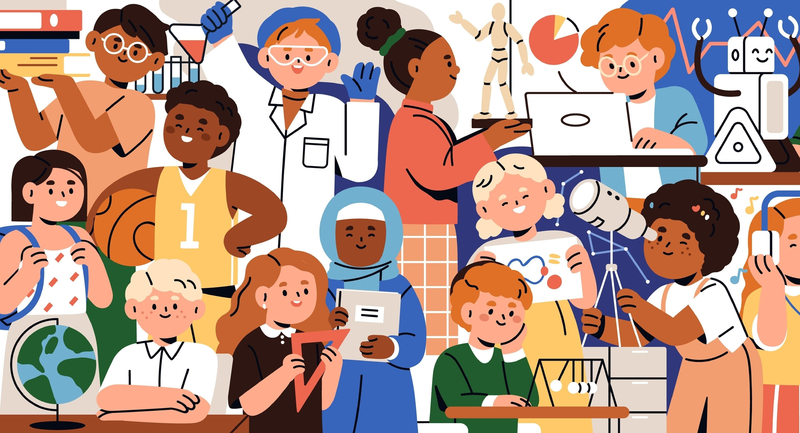Creativity, ingenuity, and innovation are the keys to success in the evolving global economy. To prepare young people for work and life in the 21st century, educators must cultivate students' creativity.
The Partnership for 21st Century Skills stresses the importance of creativity in its guide, 21st Century Skills, Education & Competitiveness: "Many of the fastest-growing jobs and emerging industries rely on workers' creative capacity—the ability to think unconventionally, question the herd, imagine new scenarios, and produce astonishing work."
Some of these emerging industries will generate jobs that do not even exist yet, explains Leslie Owen Wilson, a professor in the School of Education at the University of Wisconsin–Stevens Point. As an example, she points to green industries that use waste products in new ways.
"A future job may be a supervisory position of a landfill that traps methane gas," Wilson says. "One of the things that's going to be required [in the workforce] is adaptation and flexibility."
- Capturing—preserving new ideas.
- Challenging—giving ourselves tough problems to solve.
- Broadening—boosting creativity by learning interesting new things.
- Surrounding—associating with interesting and diverse things and people.
Epstein says that the most important of these competencies is capturing. He suggests teachers provide students with a way to capture their ideas on a daily basis in an idea folder or idea box.
"So-called 'creative geniuses' are all strong with capturing. They jot down a new idea when it pops into their head. If they can't preserve it, they get frustrated," Epstein says.
Nurturing those skills in the classroom is an important task, but it does not have to be a daunting one. Educators can effectively implement strategies in their daily teaching to help students tap into their creativity.
"Teachers have the power to establish these creative habits. You're giving young people permission to have these ideas," Epstein says.
Modeling Creativity in the Classroom
In their book How to Develop Student Creativity, authors Robert Sternberg and Wendy Williams state, "The most powerful way to develop creativity in your students is to be a role model. Children develop creativity not when you tell them to, but when you show them."
One way to model creativity is to show imagination in teaching. Nancy Flanagan, a 31-year teaching veteran from Michigan, had great success when she developed an interdisciplinary program that traced the history of music for her middle school band students. "It was amazing how the students responded," she says.
As a final project, Flanagan had the students create a piece of music in a historical style of their choice. Although she gave them four weeks to complete the project, Flanagan says her students were so enthusiastic that, after she gave the assignment on Friday, most of them had completed it by the following Monday.
"The works they did were terrific," she says. "Students sat down at their keyboards, put their creations on disc, and used technology."
Flanagan discovered that, by actively engaging her students in challenging tasks, they produced impressive work. "The best stuff came from kids who were not necessarily scholars," she says. "Creative thinking is for absolutely everyone. It's not something that should be reserved for only the best and brightest."
Making Mistakes Meaningful
Creative exercises should not be confined to disciplines such as music and art.
"Creativity is at the heart of problem-solving," Epstein says. "Students will always have problems to solve, both in their personal lives and work lives. If you help them develop creative competencies, they will be better equipped for the world."
Flanagan, who has also taught math, urged her students to use creativity in solving tricky problems.
"Math can be an enormously creative field," she says. Often, she encouraged students to analyze a problem and try to determine why using a particular algorithm was the best solution. "The way to teach creativity is to constantly stop and ask, Why?" Flanagan says.
Flanagan recommends giving students opportunities to take risks and make mistakes while experimenting. "If you put a problem out there without modeling it first and let kids flail away at it, they will try multiple things," Flanagan says.
She says her students sometimes pushed back against solving problems on their own because they feared making mistakes. "Kids don't want to make mistakes; they want to be told how to solve the problem," she says. In these instances, teachers must give students permission to make mistakes.
Sternberg and Williams explain that when students get things wrong, teachers should "ask them to analyze and discuss these mistakes. Often, mistakes or weak ideas contain the germ of correct answers or good ideas."
Just Five Minutes a Day
Epstein recommends that teachers dedicate five minutes a day (15 minutes a week total) of class time to creative training exercises.
"It doesn't take much; it's not like you need to teach a whole course on creativity," he says. "But you need to keep creative tendencies alive in students."
For example, Epstein encourages teachers to set aside a few minutes a day to allow elementary students to just let their imaginations run wild. "There's no greater freedom than the freedom of daydreaming," he says.








